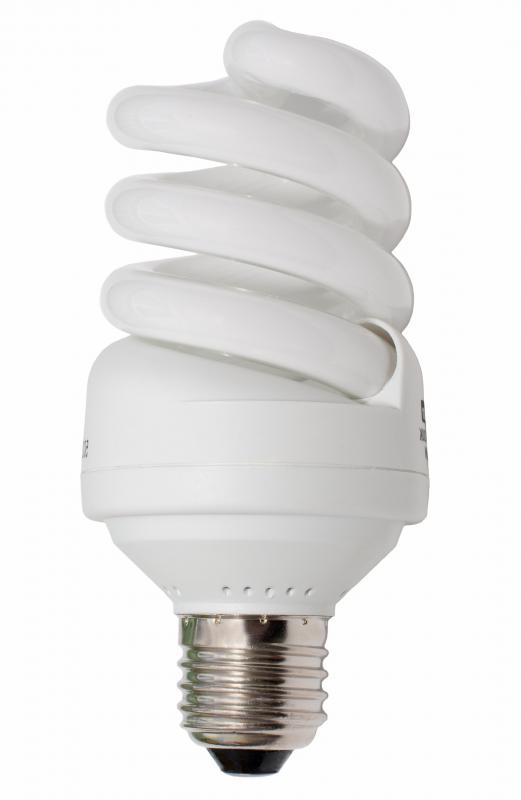At AllThingsNature, we're committed to delivering accurate, trustworthy information. Our expert-authored content is rigorously fact-checked and sourced from credible authorities. Discover how we uphold the highest standards in providing you with reliable knowledge.
How do I Reduce Emissions?
Reducing emissions is crucial in helping to protect the environment. Most carbon dioxide emissions, or greenhouse gases, are created through human activity. These activities include the burning of fossil fuels to run vehicles, provide electricity and create heating. There are many things that each of us can do to reduce emissions that add up and create negative effects in the environment.
Driving a vehicle less often is a good way to start to reduce emissions, since carbon dioxide emitted from vehicle use is a major cause of environmental pollution. Rather than driving to the corner store or other short distance, taking a walk benefits your physical health. Rather than driving to a gym to work out, using a bicycle as a workout tool provides physical exercise and also serves as a way of transportation. Some people even bike to work and this can greatly reduce emissions. Some people may give up driving a vehicle altogether if they move to a downtown area with shops and other amenities within walking distance.

Living as close as possible to your daily workplace helps cut down on how much fossil fuel you burn as well as saves you driving time and gas money. Carpooling is a popular way to cut down on the amount of vehicles used in daily commutes and most areas have carpool lanes to allow for a faster commute as well. Larger companies often have a carpool list posted so employees living near each other can reduce emissions and cut costs by commuting to work in the same vehicle.

In the home, little ways to reduce emissions can add up. Having good insulation and double glazed windows help keep energy in, but even small things such as preventing drafts in doors through proper sealing are useful. Turning down the heat also saves energy in the home. Try wearing an extra sweater and warm socks before automatically turning the heat up.

Energy Star appliances and energy saving light bulbs help save on energy output and save money on bills, too. Turning off any lights not being used in the home is important. When it comes to shopping for the home, instead of buying products that usually require carbon emissions in manufacturing processes, choose reusable products that also cut down the amount of garbage in landfills. For example, instead of going through rolls of paper towels when cleaning, use rags that can last for years by being washed and reused. Buy local produce rather than fruits and vegetables that need long-distance transportation to get to your table — you may even want to grow your own produce for fresh food at your doorstep.
Frequently Asked Questions
What are the most effective ways to reduce my carbon footprint at home?

Reducing your carbon footprint at home can be achieved through energy efficiency and renewable energy. According to the U.S. Environmental Protection Agency, using energy-efficient appliances, insulating your home, and switching to renewable energy sources like solar panels can significantly cut down emissions. Additionally, reducing waste by recycling and composting helps lower methane emissions from landfills.
How does reducing meat consumption impact emissions?

Reducing meat consumption, particularly red meat, can have a profound impact on emissions. The United Nations' Food and Agriculture Organization estimates that livestock accounts for 14.5% of global greenhouse gas emissions. By adopting a plant-based diet or reducing meat intake, you can decrease the demand for livestock farming, which is a major source of methane and deforestation-related emissions.
Can changing my travel habits really make a difference in emissions?
Yes, changing travel habits can significantly reduce emissions. Opting for public transportation, carpooling, biking, or walking instead of driving alone can lower your carbon footprint. The U.S. Department of Transportation notes that if just one person in a 100-mile car commute switches to public transportation, it can reduce annual CO2 emissions by 4,800 pounds.
What role does energy consumption play in household emissions, and how can I reduce it?
Energy consumption is a major contributor to household emissions, primarily due to heating, cooling, and electricity use. To reduce this, the Energy Saving Trust recommends actions like turning down your thermostat, using energy-efficient light bulbs, and unplugging devices when not in use. These simple steps can lead to a significant reduction in your home's energy consumption and emissions.
Is it better for the environment to buy local products?
Buying local products can be better for the environment as it often reduces the emissions associated with transportation. The Local Food Program at Iowa State University suggests that local food systems can reduce food miles, the distance food travels from production to consumer, thereby cutting down on greenhouse gas emissions from transportation.
How does conserving water help reduce emissions?
Conserving water helps reduce emissions because significant energy is used in water treatment and distribution. The California Energy Commission reports that water-related energy consumption accounts for nearly 20% of the state's electricity use. By fixing leaks, taking shorter showers, and using water-efficient appliances, you can reduce the energy required for water heating and treatment, thus lowering emissions.
AS FEATURED ON:
AS FEATURED ON:















Discuss this Article
Post your comments